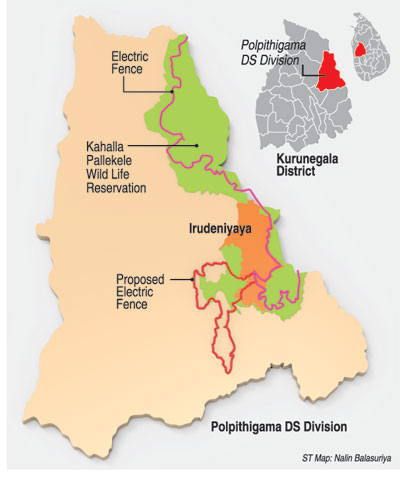News
Farmers vow to block elephant corridor plan
 The Irrudeniyaya electric fencing program to prevent wild elephants entering into human habitat has come to a standstill after farmers’ unions lodged a complaint with the Human Rights Commission this week.
The Irrudeniyaya electric fencing program to prevent wild elephants entering into human habitat has come to a standstill after farmers’ unions lodged a complaint with the Human Rights Commission this week.
All-Island Farmers Federation (AIFF) National Organiser Namal Karunaratne said farmers say they would face disadvantage over the Department of Wild Life’s extension of the electric fence from the Kahalla-Pallekelle sanctuary, where more than 400 elephants live.
He said the government intended to connect two areas of the sanctuary with a 42km corridor extension towards the Hakwatuna Oya and around the Hakwatuna Oya reserve.
The corridor, which would be 800m wide and about 1km long, would connect the Kahalla-Pallekelle Wildlife Reservation (Sanctuary) to the Hakwatuna water reservoir as well as extend 42km around the reservoir.
The Wildlife Department is trying to solve problems caused by the fact that villages have sprung up between the forest reserve and the elephants’ water source, the Hakwatuna water reservoir, and that elephants outside the fenced Kahalla-Pallekelle sanctuary are trapped in small pockets of forest in between human settlements.
The department wants to demolish some houses and use that space to create a path to connect small pockets of forests to the main reserve as well as include the Hakwatuna water source in the reserve. Then it plans to drive some 20 elephants living outside the reserve into the sanctuary.
“If the government plan is implemented 17 families will be displaced while the villagers will have to abandon the 19,000 hectare reserve and small water tanks in the area as well as two roads,” Mr. Karunaratne said.
Farmers’ homes and farmland would be lost and residents would lose Rabe Malsiripura Road, used by about 2,750 people each day.
Mr. Karunaratne said farmers also worry about people who live around the fenced area because if elephants escape the fence they will have direct access to crops and villagers’ homes.
Wildlife officials contend that if elephants gain some extra land conflict with humans would be reduced because department was simply creating an elephant corridor to direct the elephants towards the sanctuary.
The Officer in-Charge of the Hakwatuna Wildlife Range, Gamini Bandara, said all the other nearby villages supported the project but that 20 families in Irrudeniyaya were refusing to move, delaying the work.
“Others are facing threats from elephants due to these people,” Mr. Bandara said. “Their concern for their land is understandable but we can provide them with a two-acre property and a house with the help of the Housing and Construction Ministry.”
The Wildlife Department’s Director of Operations, W.S.K. Pathiratna, said the department’s plan would only see the removal of houses illegally built on the department’s territory.
“Even though we offered them land and a house these people have gone to the Human Rights Commission seeking legal help to stay in encroached land,” he said.
Mr. Pathiratna said that if these villagers were obdurate the department would be forced to take legal action against all 1,200 families who have encroached on jungle preserves.
Irrudeniyaya is one of 311 villages in the Polpithigama division, which has some 96,360 acres inhabited by 12,190 people who engage in cultivation. The Divisional Secretary of Polpithigama, W.G.W Wanasinghe said as areas such as Irrudeniyaya developed state land and wildlife areas had gone under cultivation.
The government, he said, proposed to enclose 12 Grama Niladari areas with an electric fence. The areas to be included are Syamabalangamuwa, Thalawa, Moragollagama, Bunnawa, Galhitiyawa, Herathgama, Dambe, Pothuwila, Nikawahaera, Halmilla Wewa, Agulgamuwa and Imihaminegama.
Mr. Wanasinghe said the government had already offered villagers a compromise by reducing the width of the electric fence so that fewer houses would be demolished. Environmentalist and Chairman of the Biodiversity Research Circle, Supun Lahiru Prakash, said giving more space to elephants at in the North-Western Province qas a good move.
| Child trampled to death Tragedy struck a village in the Baloruwa area in Thanamalwila this week when a nine-year-old girl died after being attacked by an elephant on her way to school. Hasini Ratnayake was trampled to death and her grandfather, A.M.H. Jayaratne, who was with her, sustained serious injuries in the attack, which took place around 6.45 am on Wednesday close to Balaharuwa Vidyalaya. Officer in Charge (OIC) of Thanamalvila Police H.C Panawala said in the aftermath of the incident local villagers had begun protests obstructing the road. The villagers demanded that the Wildlife Department erect a new fence for them and relocate the dangerous elephant. They said that even though there is an electric fence alongside the road elephants breached it and came into their villages. The department said a team of officials including two veterinarians had been dispatched to catch the rogue elephant. |

